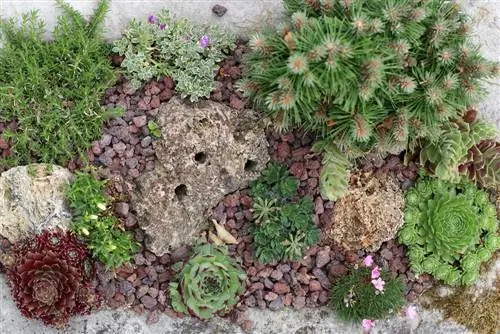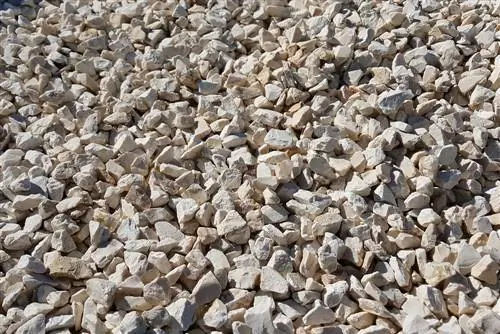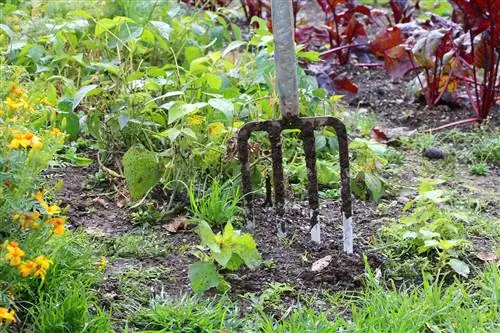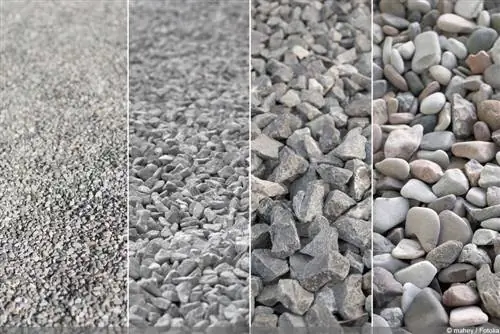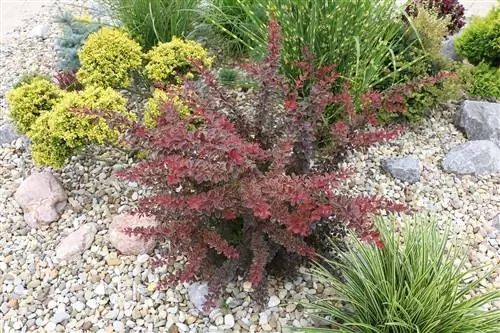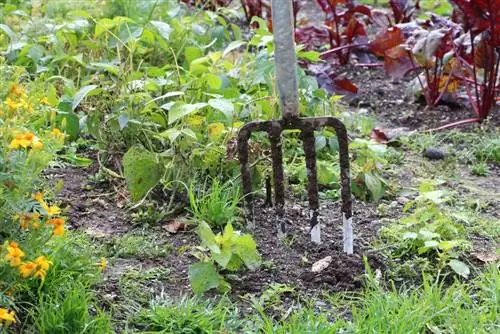- Author admin [email protected].
- Public 2023-12-17 03:39.
- Last modified 2025-01-24 12:45.
It is well known among garden owners how much work really has to be put into the home garden. If green spaces are created in the garden or beds are filled with plants, they require almost daily care. Things are a little different with gravel gardens, regardless of whether they are large areas or smaller areas in the garden that can be easily maintained.
The special thing about gravel gardens is not only that they are very easy to care for, but also that they can be designed completely individually.
Preparations for designing the gravel garden
First of all, you should consider which areas should be designed or whether it should be the entire garden. However, due to the elimination of the plants, passers-by and neighbors can see into the garden. Therefore, it must be considered in advance whether planting shrubs or hedges at the property boundaries might make sense. Hedges or shrubs such as bamboo hedges are suitable for this. Often the neighbors have already planted plants around the property boundaries or installed a privacy screen. If there is a field or forest behind the garden, the gravel garden can remain open to that side. This visually enlarges the garden and creates a feeling of freedom and space.
If a privacy screen is to be installed, you can choose between different materials. If a gravel garden is to be created in the Japanese style, you can use a privacy screen made of bamboo or wood. But a privacy screen made of willow also looks natural and warm. A stone fence or a wall can be built next to it. While these two options are the ones that will last the longest, they are also the ones that involve the highest cost and the most work. But wooden privacy fences also do their job. Plastic tarpaulins or plastic mats appear less inviting and natural.
Choosing the right place for the gravel garden
Gravel gardens cannot be created everywhere. Of course, slopes are not suitable for this, as the gravel garden would slip during the first downpour. You should also choose a sunny and warm place. On the one hand, this is due to the type of plants that can be used here. On the other hand, the gravel and the underlying layers must dry quickly after rain. Steep slopes and shady places should therefore not be chosen for the gravel garden.
Choosing the right plants for the gravel garden
Gravel gardens should be filled with easy-care yet expressive plants so that they retain their typical charm. These plant species also include:
- Sedum
- Golden Spurge
- Steppe Iris
- ornamental onion
- Steppe Sage
- Scented Nettle
- Candelabra Mullein
- palm lily
- white buddleia
- common boxwood
- tussockgrass
- yellow fireweed
- Imperial Crown
In principle, you can choose from a variety of different plant species. However, delicate grasses and delicate flowers are more suitable for gravel gardens than large, massive plants. However, care should be taken to ensure that these are plants that thrive in drought. Therefore, typical plants for gravel gardens come from the Mediterranean or the steppe. Grasses can be used almost anywhere in the gravel garden. Here too, however, care should be taken to ensure that these, like the other plants, are planted in small groups. Thanks to their straight growth, the ornamental grasses can provide structure and also separate the different areas from one another. For grasses you can choose, for example, the giant feather grass or the silver ear grass.
Preparing the garden
Ideally, the gravel garden is designed in autumn. In order to prepare the garden for landscaping with gravel, the topsoil is removed from the designated areas to a depth of around 25-30 cm. However, for heavy or compacted soils, it is necessary to extract at least 40 cm underground. This removed topsoil is now mixed with coarse gravel in approximately equal parts. A mixture of 16 to 32 should be used. The small gravel grains here have a diameter of between 16 and 32 millimeters. After thorough mixing, this mixture is added back to the excavated area. However, this is not filled to the top, but only two thirds. A plastic fleece is placed on top. By inserting the fleece, the growth of weeds can be largely prevented. The plants are now positioned on the fleece. Here the fleece is cut in a cross shape.
After positioning, the gravel is applied to the fleece and around the plants. Care should be taken not to choose white gravel. This reflects too strongly when exposed to sunlight. A cream or sand-colored gravel should be chosen here. Dark gravel has the advantage that it warms up more than light gravel, especially in spring, and therefore stimulates plant growth. If sandstones or paving stones are to be used as a boundary between different gravel areas or areas with topsoil, they should be positioned now. However, this happens next to the fleece as the stones are pressed into the earth. In order to differentiate the different areas more clearly, different colors of gravel can be used.
Decorate the gravel garden
In addition to the plants that are already used for decoration and design, other elements such as sculptures or statues made of stone, decorative stones or plant pots made of clay can be added to the gravel garden. Figures are particularly popular in Japanese gravel gardens. Here the gravel garden is laid out in a circle. Here you can also work with boxwood, which can be cut into the desired shape, for example balls. Vases or old wooden barrels can also be brought into the gravel garden for decoration. If you like something exotic, you can also use ferns and palm trees instead of grasses. However, it must be borne in mind that these may have to be dug up again for overwintering. In addition to the sculptures, seating areas or small ponds can also be designed in the middle.
Maintenance of the gravel garden
The gravel garden is generally very easy to care for. Because of the fleece introduced, weeds usually do not manage to grow through the gravel. If weeds do get through, they can't get a hold of the gravel and can be pulled out very easily. If non-sensitive plants have been used in the gravel garden, it does not need to be watered very frequently. It may only become necessary to water the plants in mid-summer. In the first year, however, the newly planted plants should be planted more often so that the plants can root well into the subsoil. Plants that are not winter-proof should ideally be placed in pots in the gravel garden. A gravel bed is usually very easy to care for. Of course, this also applies to the entire garden. Similar to a layer of mulch, the gravel prevents weeds from spreading excessively.
With the right planting, a gravel garden will show off its full beauty after just a few weeks and months. At first the plants often look a bit lost, but that quickly goes away. The beauty of a gravel garden is the contrast between the fresh green and bright colors and the bare gravel. The idea with gravel is ideal for Asian-style gardens.
What you should know about the gravel garden in brief
Requirements
- The best time to create a gravel garden is in autumn, i.e. September or October.
- It is important to have the appropriate soil material, the right location and the perfect choice of plants.
- A stony substrate is particularly suitable for plants that need a lot of air in the root area and that do not like waterlogging or wet soil.
- Precipitation water can drain easily between the pebbles. The cavities between the stones fill with air very quickly and the earth dries out.
Plant selection
- It is important to ensure that not all plants bloom at the same time, but that only a few bloom at a time, but all year round (except winter).
- Some evergreen plants provide color in winter.
- Crocuses are suitable as early bloomers in a gravel bed, nicely arranged in larger groups.
- For spring blossoms, for example, golden spurge and steppe sage are recommended. They bloom in May.
- Scented nettle, sedum and stonecrop bloom until the frost, all summer long.
- In winter, the inflorescences left standing are impressive.
Create and plant gravel garden
- The boundaries of the areas must be marked out.
- Then a layer of soil of about 10 cm must be removed.
- Lay the areas planned as gravel beds or paths completely with a root fleece. Edges must overlap by approx. 10 cm.
- The pot for the plants is first buried empty. Will be planted later.
- Now fill in 5 cm of fine gravel.
- Place another fleece over it. This way you can be sure that no weeds will find their way. Cut fleece over pots.
- Now plant the trees in the pots.
- Where other plants are planned, soil must be added.
- Insert plants.
- Cover everything with thick gravel. You can also use granite gravel.
Conclusion
Creating a gravel garden requires some effort. However, the care is then much easier. An entire garden made of gravel actually only works in an Asian-planned garden. Otherwise, a small front garden still looks very nice. The layers must be laid out correctly so that the purpose of preventing weeds is achieved. Suitable sculptures and small fountains are also suitable for such gravel gardens, because water is an essential part of Asian gardens.

